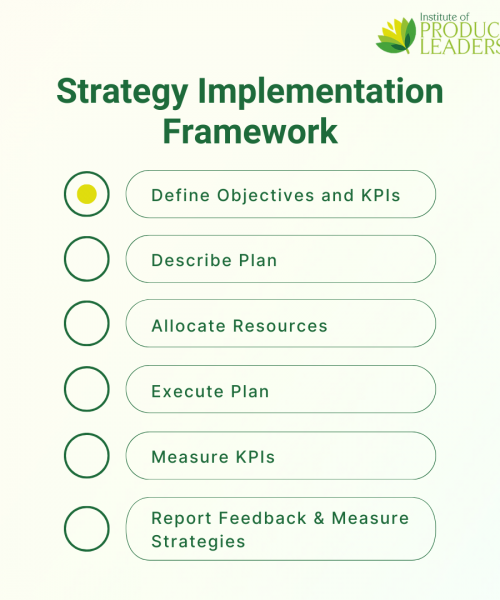Implementing a Successful Strategy: A Simple Six-Step Checklist
- Product Management & Strategy
- 5 min read
By Prabhakar Gopalan – Chief Revenue Officer at TeleVet
Implementing a successful strategy is crucial for any organisation. However, many companies struggle to effectively execute their strategies due to a lack of clear objectives, poor resource allocation, and a failure to measure key performance indicators (KPIs). In this blog, we will discuss a simple six-step checklist that can help you ensure the successful implementation of your strategy.
Key Takeaways:
- Successful strategy implementation is vital for organizations, but challenges like unclear objectives, poor resource allocation, and inadequate measurement of KPIs can hinder the process.
- While delivering results quickly is crucial, maintaining product quality is equally important to prevent customer dissatisfaction and ensure long-term success.
- Strategy implementation requires continuous monitoring, evaluation, and adjustment based on customer feedback, market trends, and competitor actions.
Step 1: Define the Objectives and KPIs
The first and most important step in strategy implementation is to define clear objectives and KPIs. Without a clear set of objectives, it is impossible to develop an effective strategy. Objectives should consider the context, time frame, dependencies, and whether they are operational or aspirational. By setting well-defined objectives and KPIs, you can ensure that your strategy aligns with the overall business goals.
Using the OKRs Framework
One framework that can be useful for setting objectives and KPIs is OKRs (Objectives and Key Results). OKRs provide a structured approach to setting goals and measuring progress. For example, an objective could be to “Launch Acme widget in Q2 with 300 daily active users.” This objective is specific, measurable, and aligned with the business goal. By adopting frameworks like OKRs, organisations can enhance their strategy implementation process.
Step 2: Describe the Plan
Once you have defined your objectives and KPIs, the next step is to describe the plan. This involves breaking down the objectives into actionable tasks and creating a roadmap or sprint plan. It is essential to clearly communicate how you will achieve your objectives and allocate resources accordingly. By having a well-defined plan, you can ensure that everyone in the organisation understands their roles and responsibilities.
Step 3: Allocate Resources
Resource allocation is a central economic problem in strategy implementation. It is crucial to allocate the right resources, including time, talent, and leadership, to execute your plan effectively. Adequate staffing and the right culture are essential for the successful implementation of your strategy. As a product manager, you need to navigate the internal politics of the organisation and influence resource allocation to align with your strategy.
Step 4: Execute the Plan
Execution is a critical step in strategy implementation. It is not just about shipping code but also about ensuring that the features and products you develop align with your objectives. It is important to consider whether you are building minimum viable products (MVPs) or complete features and how customers will use them. Additionally, it is crucial to have a follow-through plan after the initial launch of an MVP to capitalise on its success and continue building on it.
Step 5: Measure KPIs
Measuring KPIs is an integral part of strategy implementation. Key performance indicators provide insights into whether your strategy is working effectively. Metrics such as throughput, cycle time, and work in progress can indicate the organisation’s productivity and efficiency. By continuously monitoring and analysing these metrics, product managers can identify areas for improvement and make data-driven decisions.
The Importance of Quality
While delivering results quickly is important, it should not come at the expense of quality. Measuring the quality of the products and features you develop is crucial. Poor quality can undermine the success of your strategy and lead to customer dissatisfaction. Therefore, it is essential to prioritise quality assurance and ensure that your products meet the expectations of your customers.
Step 6: Adjust Strategy Based on Feedback
Finally, strategy implementation requires continuous monitoring and adjustment based on feedback. It is important to listen to your customers, engage with them, and understand their needs. By actively seeking customer feedback and observing how they use your products, you can identify opportunities for improvement and make necessary adjustments to your strategy. Additionally, it is crucial to stay informed about market trends and competitor actions to adapt your strategy accordingly.
Summary
Implementing a successful strategy requires careful planning, resource allocation, and continuous evaluation. By following a simple six-step checklist, organisations can ensure that their strategies are effectively executed. Defining clear objectives and KPIs, describing the plan, allocating resources, executing the plan, measuring KPIs, and adjusting strategy based on feedback are essential steps for successful strategy implementation. By adopting these practices, organisations can enhance their competitiveness and achieve their business goals.
Frequently Asked Questions
Product Managers focus on developing products and managing the product roadmap, while Business Analysts focus on developing business capabilities and determining requirements.
Yes, many Product Managers come from a Business Analyst background.
Communication, technical expertise, marketing inclination, strategic thinking, and customer empathy.
In general, product managers tend to be paid more than business analysts. Product managers play a key role in driving product success and profitability, making strategic decisions, and directing cross-functional teams.Their responsibilities include product strategy, market research, stakeholder management, and delivering innovative solutions.
A product manager often earns a higher salary and has access to greater career opportunities due to their strategic importance and the value they bring to the company. Their ability to drive sales, make data-driven decisions, and lead product development initiatives have made them highly sought-after and highly paid professionals in the industry.
Defining product strategy, managing the product lifecycle, coordinating cross-functional teams, marketing the product, and continually improving it.
Both roles involve understanding requirements, communicating with stakeholders, and analyzing data.
Transitioning to a Product Manager role requires developing strategic thinking, understanding customer needs, and enhancing communication and leadership skills. It also involves gaining technical expertise and marketing knowledge.
Transitioning from a Business Analyst role to a Product Manager role offers several advantages, including:
- Strategic decision-making: As a Product Manager, you have the opportunity to make strategic decisions that shape the direction of the product and align it with business goals.
- End-to-end product ownership: Product Managers have ownership over the entire product lifecycle, from ideation and development to launch and ongoing improvement.
- Customer focus: Product Managers have a stronger focus on understanding customer needs, market trends, and competitive landscapes, allowing them to create products that deliver value and drive business growth.
- Cross-functional collaboration: Product Managers collaborate with various teams, including design, engineering, marketing, and sales, fostering cross-functional collaboration and leadership skills.
- Increased career prospects: Transitioning to a Product Manager role opens up new career opportunities and provides a broader skill set that is highly valued in the industry.
Several skills and experiences from a Business Analyst role are transferable to a Product Manager role, including:
- Requirement gathering and analysis: Business Analysts are adept at understanding user needs and translating them into actionable requirements, a skill crucial for Product Managers in defining product features and functionality.
- Data analysis: Business Analysts often analyze data to identify trends and patterns. This skill is valuable for Product Managers in making data-driven decisions and evaluating the success of their products.
- Stakeholder management: Business Analysts work closely with stakeholders to understand their requirements and expectations. This experience helps Product Managers effectively manage relationships and communicate with stakeholders across the organization.
- User empathy: Business Analysts focus on understanding user needs and pain points. This user-centric approach is essential for Product Managers to develop products that solve customer problems and create a positive user experience.
- Domain knowledge: Business Analysts often acquire domain-specific knowledge through their work. This knowledge can be leveraged by Product Managers to gain a deeper understanding of the industry, market trends, and customer preferences.
Transitioning from a Business Analyst to a Product Manager requires acquiring additional skills and competencies, such as:
- Product strategy: Product Managers need to think strategically and align the product roadmap with business goals and market opportunities.
- Market research: Developing expertise in market research enables Product Managers to identify market trends, customer needs, and competitive insights to inform product decisions.
- Leadership and influence: Product Managers must be able to lead cross-functional teams, influence stakeholders, and effectively communicate their vision and product strategy.
- Prioritization and decision-making: Product Managers need to make informed decisions by prioritizing features, resources, and trade-offs based on business value and customer impact.
- Business acumen: Developing a strong understanding of business models, revenue generation, and financial metrics helps Product Managers make sound business decisions and justify product investments.
About the Author:
Prabhakar Gopalan – Chief Revenue Officer at TeleVet







